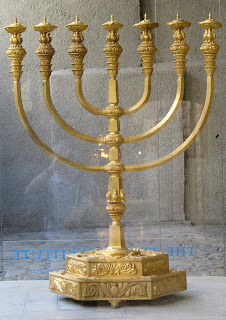
There are a number of perushim by the Ramban on the Torah which have achieved the status of "world-famous" within the Yeshiva world. However, in the world of the Kabbalists there is one perush of the Ramban which is so famous and so fundamental to Kabbalistic philosophy, that I am inclined to refer to it as "Biblical". I am going to discuss the Ramban's "Biblical" comment about how the world was created. Nevertheless, since I do not want to confuse anyone, I will just refer to this comment of the Ramban as "world-famous", but we will know the real truth.
The "world-famous" Ramban in Parshat Bereshit concerns the first pasuk in the Torah
-
בראשית ברא אלוקים. In reality, this is an extremely difficult phrase to translate accurately. The complex nuances of the Biblical grammar are barely within my grasp (hat-tip to Profs. Steiner and Eichler) but much too difficult to explain here.
המבין יבין.
Nevertheless, the word
בראשית is generally translated as, "beginning" - as in, "In the beginning blah blah blah." However, Chazal treat the letter "
ב" at the beginning of the word as a preposition and translate the word as, "with
ראשית." Now don't get lost because we are almost at the end -
ראשית is generally translated as, "the best". Chazal translate the first phrase in the Torah as, "Elokim created with the best." Take a look at Rashi on this pasuk and you will see some suggestions for meanings of
ראשית: B'nei Israel and the Torah. (Truthfully, Rashi translates the "
ב" as, "for the sake of" - so Rashi would translate this phrase as, "HaShem created for the sake of the Torah".)
Ramban the Kabbalist is struggling to reconcile the first pasuk of the Torah with the Kabbalistic concept of creation ex nihilo. That is to say
יש מאין, or something from nothing. The word
ראשית refers to the very first "stuff" that was created by HaShem in the finite universe. Ramban explains that Greek philosophy has a similar idea of the first "stuff" that was used to create the universe - "hiyuli". (My Greek is a little rusty if not non-existent, so I welcome any help from any blog-like people out there.) According to Ramban, there was a single act of something from nothing creation, and the Torah calls the created stuff
ראשית. All of the olamot and sefirot, and molecules and quarks are all made from this
ראשית. And there you have it, Ramban uses a little Greek philosophy to help explain how the first phrase in the Torah actually refers to the fundamental Kabbalistic concept of tzimtzum.
Photo Credit - http://www.nasa.gov/mission_pages/solar-b/solar_019.html
 I was learning a Mishnah the other day and came across an interesting piece of Talmudic realia.
I was learning a Mishnah the other day and came across an interesting piece of Talmudic realia.


























.jpg)











